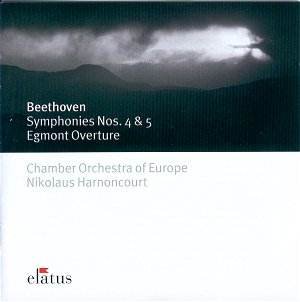This is a very disappointing disc on many counts.
First, the sound is dry. Second, the performances
are wayward and often dull and third, Sir Roger Norrington's recent
performances put these performances to shame.
The Symphony no. 4 is a sunny sparkling work
but not so here. It opens well with a real sense of mystery but
perhaps a little too polished and clinical but the eerieness is
certainly there. It plods a bit, particularly when the pizzicato
accompaniment is introduced. The first powerful entry is somewhat
raw and the sound is both dry and clipped and this unsatisfactory
sound pervades the whole disc. The main allegro lacks the attack
and energy that Norrington gives it (Hänssler CD93.085) and
the striding bass line is lost with the Chamber Orchestra of Europe.
In fact, the recording favours the treble sound at the expense
of the bass and one can be forgiven in believing that the double
basses are on strike and the timpanist is in another room. To
add to the frustration my copy was damaged at 4 and a half minutes
in. The performance is too clinical and lacking in the vibrancy
and energy that Norrington gives to it. At times Harnoncourt makes
the music muddy and there is a definite lack of clarity. The balance
is wrong and the tempo too slow. There is a lack of drive and
the sunny disposition of the music is completely lost. In some
respects the performance is so highly polished that the drama
and joy is lost. The section of quiet foreboding drags and lacks
tension. Even in the glorious moments exuberance and joy simply
is not there. This Teutonic style of playing Beethoven is always
unsatisfactory and, in any event, weren't Beethoven's antecedents
Dutch? This movement is too leisurely and anaemic.
The slow movement is a truly lovely movement
but, as with the previous movement, details do not come through.
They do in the Norrington version. Here the music is too refined
or cautious. I was troubled by the balance which again favours
the top register. There is cold emotion here and it does not convince
or communicate. The horn playing is immaculate.
The scherzo is a little tacky reminding me of
a cheap fairground. The excessive refinement of the earlier movements
now does a U-turn. The trio is nondescript and sterile.
The finale fares better at times although the
high register is too strong. The oboist is very good but the music
is cluttered. It does not have the clarity of line one is entitled
to expect. The music lacks the sparkle and freshness.
I will not listen to this performance again.
The Symphony no. 5 is famous but if I were listening
to it for the first time in this performance I would hate it.
The opening phrase is almost right. Few conductors get it right.
It is a quaver rest followed by three quavers, bar line and a
minim. Most conductors play the first bar as three equal notes
as three crotchets in a triplet and emphasise the first note as
if were the first beat of the bar. Others hang on the first note
making it a crotchet followed by two quavers. How can professionals
make such ghastly mistakes? It probably stems from the abuse of
this phrase during the war when it was used as a sort of victory
theme.
Some of the playing is smudgy and the horns sometimes
sound like klaxons and quite ludicrous. The performance is somewhat
raucous and there are terrible lapses of control (5. 10 and 6
35, for example).
The slow movement begins with a sound like a
bee in a matchbox but Harnoncourt brilliantly captures the Alla
marcia material. What I cannot abide is the sudden and unauthorised
sforzandos which Rattle also indulges in so that the music becomes
a caricature. The movement does not hang together but is like
a patchwork quilt and a tatty one at that.
The scherzo is a strange movement. Again there
is a lack of control. The music does not gel and when the quiet
music arrives there is an evident lack of purpose and direction
in this performance. I listened to Reiner's performance to see
and hear how it was done and marvelled at this older version.
The finale lacks power and excitement. It is
not triumphant or exultant. At times it is positively limp and
at 5.45 Beethoven reverts to his bad habit of a slowing down process
which eventually leads to a race to the finishing post and all
those crashing chords which are tedious.
The Egmont overture is a fine piece but here
we have another heavy performance. The brass is often raucous
and vulgar. The quick section is muddy and madly out of control
with wayward tempi and that ghastly dry sound. All the music sounds
stale. And it is not real Beethoven!
Totally unacceptable if you love your Beethoven!
David C F Wright
David Wright's essay on Beethoven on this website
